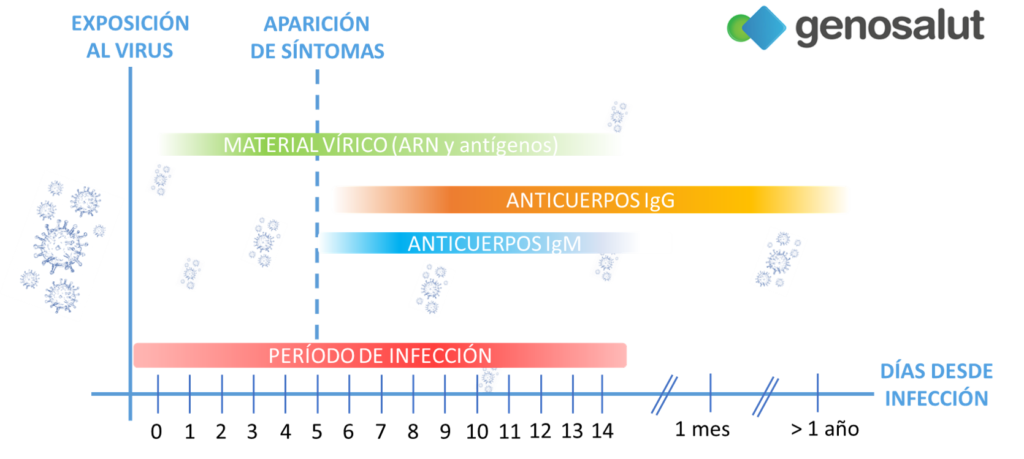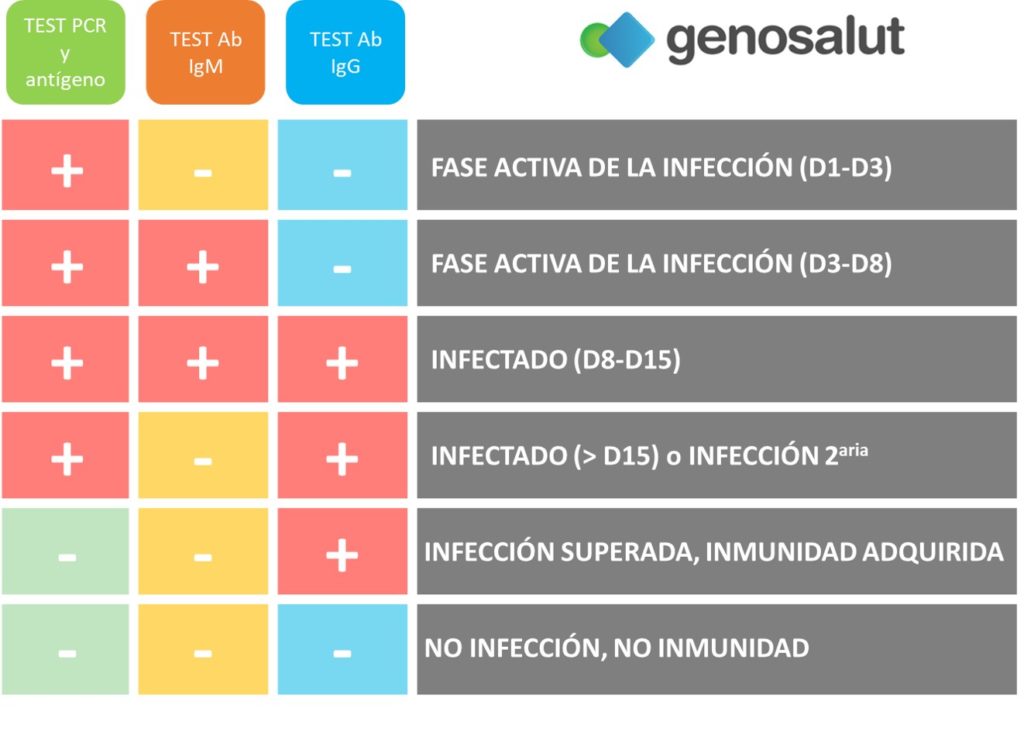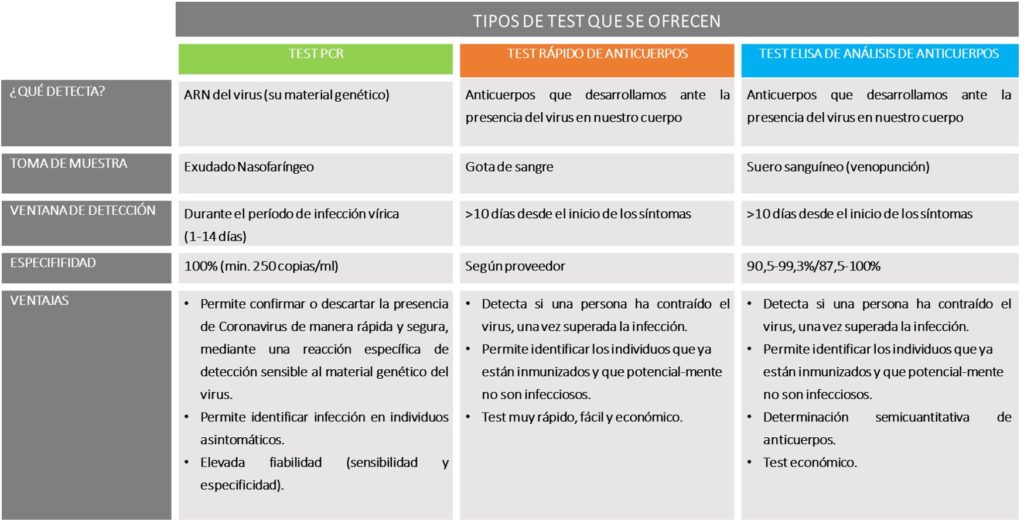What do the SARS-CoV2 coronavirus tests detect?
Surely in recent weeks you have heard about RT-PCR, serological tests, rapid tests, ELISA… but what are all these tests? What do they detect? How do they work? Are they reliable?
Below, we will try to give you a summary to clarify some concepts.
The tests currently available detect:
● The virus itself: its genetic material or some fragment of the virus, usually of a protein nature, known as an antigen.
● Antibodies: the molecules produced by our immune system if we have been infected with the virus.
What is the RT-PCR test and how does it work?
The RT-PCR test can detect the genetic material of the virus. As we explained in another blog post, viruses have genetic material (RNA or DNA) and RT-PCR can detect the presence of this genetic material (in the case of the SARS-CoV2 coronavirus it is RNA).
● A swab is used to collect a sample from the nasopharyngeal tract.
● The swab is immediately placed in a substance that inactivates the virus, i.e. it loses its infectious capacity but is still detectable (if present).
● The genetic material of the virus is then removed (there are different procedures for this).
● Finally, a reaction, the RT-PCR itself, is carried out, which amplifies the viral genetic material. Amplification is necessary for detection. To use a simile, RT-PCR acts like a magnifying glass, it amplifies whatever is to be detected whenever it is present.
The specific binding between an antigen and the antibodies it generates is the basis for the functioning of rapid tests and ELISAs.
What are rapid tests and how do they work?
Unlike RT-PCR, rapid tests do not identify virus RNA. Depending on the laboratory design, they detect antibodies or immunoglobulins (IgM and/or IgG) or antigens.
Antibodies are molecules (glycoproteins) produced by B-lymphocytes to identify and neutralise foreign elements such as bacteria and viruses in a very specific way.
Antigens are usually fragments of pathogens that are responsible for triggering part of our immune system’s defence response and the generation of specific antibodies against the pathogen in question.
● The sample (blood or exudate), is placed on a paper test strip.
● The reaction that then takes place is known as immunochromatography. The sample migrates down the strip until it reaches a region where virus proteins (in the case of detecting antibodies) or virus-specific antibodies (in the case of detecting antigens) are “stuck”.
● The results are displayed much like a pregnancy test.
How do ELISA tests work?
ELISA is an abbreviation for enzyme-linked immunosorbent assay. With the help of an enzyme-mediated reaction, ELISA can detect the interaction of antigen (e.g. pathogens; in this case the SAR-CoV2 coronavirus) and antibodies (in this case those generated by the immune system in case of infection with the SARS-CoV2 coronavirus). This test can be used to determine how many antibodies a person has generated against a particular infection.
● The ELISA assay is performed in a plastic plate with many wells, which are coated with the desired antigen, in this case a fragment of SARS-CoV2.
● The blood sample and a control solution are placed in the wells. If antibodies to the SARS-CoV2 coronavirus are present in the blood, they will bind to the antigen.
● Simplifying the process, after several reaction steps and washes, the antigen-antibody binding can be detected by colourimetry. The intensity of the colour of each well will differ according to the amount of antibody in the blood sample.
Several ELISA kits are available for the detection of SARS-CoV2 coronavirus. Production differs between commercial companies and clinical results are often not comparable. The clinical sensitivity, which determines the reference value for determining positive or negative, is different for each test. The higher the sensitivity, the higher the reliability. More comprehensive reagents are more sensitive, but also more expensive to produce. The reliability of the technique is based on the sensitivity of the kit, but what ultimately lies behind the reliability is an economic issue.
At what stage of infection, disease and (possible) immunity are these tests relevant?
The RT-PCR test has so far been described as the most reliable test, but it only detects the presence of the virus. In other words, it detects the virus from the moment of infection, throughout the course of the disease (whether or not symptoms appear) and until the immune system is able to fight and eliminate the virus, and therefore it is no longer detectable.
Serological antibody or immunoglobulin tests, both rapid and ELISA, detect those antibodies that are produced during the immune response (immunoglobulin M, IgM) and those that last longer (immunoglobulin G, IgG). It takes about a week for our body to produce enough IgM molecules to be detected. Therefore, serological tests do not detect the early stages of infection, but they are able to answer the question of whether or not the disease has passed.
If I have antibodies, does that mean I am immunised for life?
The answer is very clear and it is “we don’t know”. The immunity generated by this coronavirus is still unknown. In other words, we do not know whether our resistance to the virus, which is linked to the acquisition of specific antibodies that fight new infections by the same virus, will last for a short period, a long period or forever.
How reliable are these tests?
The sensitivity and specificity of antibody tests is undoubtedly the most controversial point. One of the factors on which their reliability depends is the post-infection day on which the test is performed. The more advanced the infection, the higher the reliability. It also depends on the laboratory producing the test. Not all tests are of the same quality. What we do know is that, at the moment, the sensitivity of antibody tests is higher than antigen tests.
If you like our blog, subscribe to our newsletter





